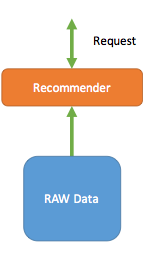A bottom-up example
Example two: design a recommendation module
A simple algo:
u1={m3,m5,m7,m11}
u2={m1,m2,m3,m4,m5,m6,m7,m8,m9}
Similarity( u1, u2 ) = 3
m - music
u - user
Similarity = # of same music for different users
Adv algo:
find his top-1 similar user. Stay tuned for future posts.
Use the 5 Steps (SNAKE)
- Step One, Scenario
- Step Two, Necessary
- Step Three, Application
- Step Four, Kilobit: data
- Last Step, Evolve
Because this question is relatively easy, we will not do case-analysis (Macro).
Instead, we do micro design by starting at the interface.
Step One, Scenario
Interface
class Recommender {
public int findSimilarUser(int userId) {
//
}
}
Step Two, Necessary
ask
- total users = 100,000,000
- total music = 10,000,000
- peak users in 3 month = 6,000,000
However, not everyone is logged in. Thus we won’t need to recommend for everybody. On average, the logged-in ratio is 1% - 30%. Let’s assume 5%.
- participation percentage = 5%
And user’s interest won’t change every minute. Let’s recalculate only after 10 minutes.
- calculation frequency = 1 update/10min/user
predict
- user analysis (skip)
- Traffic analysis (skip)
- Memory analysis (skip)
- QPS
Peak QPS = 6,000,000 * 5% / (10 * 60) = 500/s
Step Three, Application
The simpliest algorithm: BF compare. The complexity is O(m n) for each user, where m is # of music a person likes, and n is # of total users. For k users, it takes O(k m n) time (k can be = peak concurrent users).
This is roughly 0.2s per user. Thus Max QPS = 5.
One word about complexity-to-seconds estimation.
O(n ^ 3) -> 1s
O(n ^ 2) -> 0.2s
O(n) -> 20ms
O(k) -> k ms
Step Four, Kilobit: data
Very simple:

Last Step, Evolve
Read on.